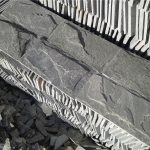Introduction
Stone veneer steps are a popular choice for homeowners looking to enhance the aesthetic appeal of their properties. These steps are not only stylish and durable but also offer a versatile design option that can complement a wide range of architectural styles. In this comprehensive guide, we will explore the benefits of stone veneer steps, the different types available, installation processes, maintenance tips, and design ideas to help you transform your outdoor space.
Benefits of Stone Veneer Steps
Stone veneer steps offer a myriad of benefits that make them a desirable choice for homeowners. One of the key advantages is their durability. Made from natural stone or manufactured stone materials, stone veneer steps are built to withstand the elements and heavy foot traffic, ensuring long-lasting performance. Additionally, stone veneer steps are resistant to fading, cracking, and chipping, making them a low-maintenance option for outdoor staircases.
Another benefit of stone veneer steps is their aesthetic appeal. With a wide variety of colors, textures, and patterns available, homeowners can customize their steps to suit their personal style and complement the existing design of their home. Whether you prefer a rustic, traditional, or modern look, stone veneer steps can be tailored to meet your design preferences.

Types of Stone Veneer Steps
There are several types of stone veneer steps to choose from, each offering unique characteristics and design options. One popular choice is natural stone veneer steps, which are crafted from quarried stone such as granite, limestone, or bluestone. Natural stone veneer steps provide a timeless and elegant look, with each step showcasing the natural beauty and variation of the stone.
For homeowners looking for a more cost-effective option, manufactured stone veneer steps are a great alternative. Made from concrete molds that mimic the look of natural stone, manufactured stone veneer steps offer a more affordable and lightweight alternative without compromising on aesthetics. These steps are available in a wide range of colors and textures, allowing for endless design possibilities.
Installation Process
Installing stone veneer steps requires careful planning and precision to ensure a durable and visually appealing result. The first step in the installation process is to prepare the site by excavating the area and creating a solid foundation for the steps. This may involve pouring a concrete footing or laying a base of compacted gravel to support the weight of the steps.
Next, the individual steps are installed one at a time, starting from the bottom and working upwards. Each step is secured in place using a combination of adhesive and mortar to ensure a strong bond with the underlying structure. Grout may be used to fill in any gaps between the steps and create a seamless finish.
Finally, the stone veneer facing is applied to the steps to enhance their appearance and provide a cohesive look. The facing material is carefully selected to match the overall design of the home and create a harmonious transition between the steps and the surrounding landscape.
Maintenance Tips
To preserve the beauty and functionality of your stone veneer steps, regular maintenance is essential. Here are some tips to help you keep your steps looking their best:
1. Clean regularly: Remove dirt, debris, and stains from your stone veneer steps by sweeping or washing them with a mild detergent and water. Avoid using harsh chemicals or abrasive cleaners that could damage the stone surface.
2. Seal the stone: Apply a sealant to your stone veneer steps periodically to protect them from water damage, staining, and fading. Be sure to choose a sealant that is suitable for the type of stone veneer you have installed.
3. Repair any damage: Inspect your stone veneer steps regularly for any signs of damage, such as cracks or loose stones. Repair any issues promptly to prevent further deterioration and ensure the structural integrity of the steps.
4. Prevent water buildup: Ensure proper drainage around your stone veneer steps to prevent water from pooling and causing damage to the underlying structure. Consider installing a drainage system or adding gravel around the steps to redirect water away from the area.
Design Ideas
Stone veneer steps offer endless design possibilities to enhance the curb appeal of your home and create a welcoming entryway. Here are Roofing slate and home value increase to inspire your next outdoor project:
1. Classic Elegance: Opt for natural stone veneer steps in a neutral color palette, such as gray or beige, to achieve a timeless and sophisticated look. Pair the steps with lush landscaping and traditional lighting fixtures for a classic and elegant entrance.
2. Modern Minimalism: Choose manufactured stone veneer steps in a sleek and contemporary design, such as straight lines and smooth surfaces, to create a modern aesthetic. Incorporate minimalist landscaping and geometric planters to complement the clean lines of the steps.
3. Rustic Charm: Embrace the beauty of natural stone with irregular shapes and textures for a rustic and inviting feel. Add wooden accents, such as railings or planters, to enhance the warmth and charm of the stone veneer steps.
4. Mediterranean Oasis: Create a Mediterranean-inspired oasis with stone veneer steps in warm earth tones, such as terracotta or sandstone. Add vibrant tiles, potted plants, and wrought iron accents to evoke the relaxed and sunny ambiance of a Mediterranean villa.
Conclusion
Stone veneer steps are a versatile and durable option for enhancing the beauty and functionality of your outdoor space. Whether you prefer the natural elegance of quarried stone or the affordability of manufactured stone, there are options available to suit every style and budget. By following proper installation techniques, regular maintenance practices, and creative design ideas, you can transform your home with stone veneer steps that will stand the test of time and impress visitors for years to come.
